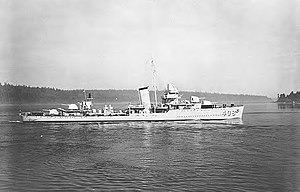USS Wilson

| |
| History | |
|---|---|
| Name | Wilson |
| Namesake | Charles Wilson |
| Builder | Puget Sound Navy Yard |
| Laid down | 22 March 1937 |
| Launched | 12 April 1939 |
| Commissioned | 5 July 1939 |
| Decommissioned | 29 August 1946 |
| Stricken | 5 April 1948 |
| Fate | Sunk off Kwajalein on 8 March 1948, after atomic testing |
| General characteristics | |
| Class and type | Benham-class destroyer |
| Displacement | 2,250 tons (full) |
| Length | 340 ft 9 in (103.86 m) |
| Beam | 35 ft 6 in (10.82 m) |
| Draft | 12 ft 10 in (3.91 m) |
| Propulsion |
|
| Speed | 38.5 knots (71.3 km/h; 44.3 mph) |
| Range | 6,500 nmi (12,000 km; 7,500 mi) at 12 knots (22 km/h; 14 mph) |
| Complement | 251 officers and enlisted |
| Armament |
|
USS Wilson (DD-408), was a Benham-class destroyer of the United States Navy.
Namesake
Charles Wilson was born in 1836 in
Later that year, Wilson also served during the capture of Confederate batteries opposite
History
Wilson was laid down on 22 March 1937 at
Wilson operated along the west coasts of the United States, Central and South America into April 1940, when she went to the
Wilson returned to the Pacific as part of a task group centered on the aircraft carrier Wasp, and accompanied it to the south Pacific in July 1942. Early in the next month, she provided bombardment and anti-aircraft services to the invasion force during landings at Guadalcanal and Tulagi. While in that area on 9 August, Wilson engaged Japanese cruisers during the Battle of Savo Island, and later rescued survivors of the sunken cruisers Quincy, Astoria and Vincennes.
Following a west coast overhaul, Wilson was back off Guadalcanal in January 1943, in time for the last weeks of the fighting there. She subsequently participated in landings on the Russell Islands, bombarded enemy positions on New Georgia and escorted shipping in and around the Solomon Islands. In November 1943, the destroyer screened U.S. aircraft carriers during strikes on Rabaul and Nauru and was similarly employed during attacks on the Marshall and Caroline Islands in January and February 1944.
In June and July 1944, Wilson served with the carrier task forces during the
Wilson was employed on occupation duty until December 1945, when she returned to the U.S. west coast. In May of the next year, she was assigned to
Honors
Wilson received 11
References
This article incorporates text from the public domain Dictionary of American Naval Fighting Ships. The entry can be found here.
